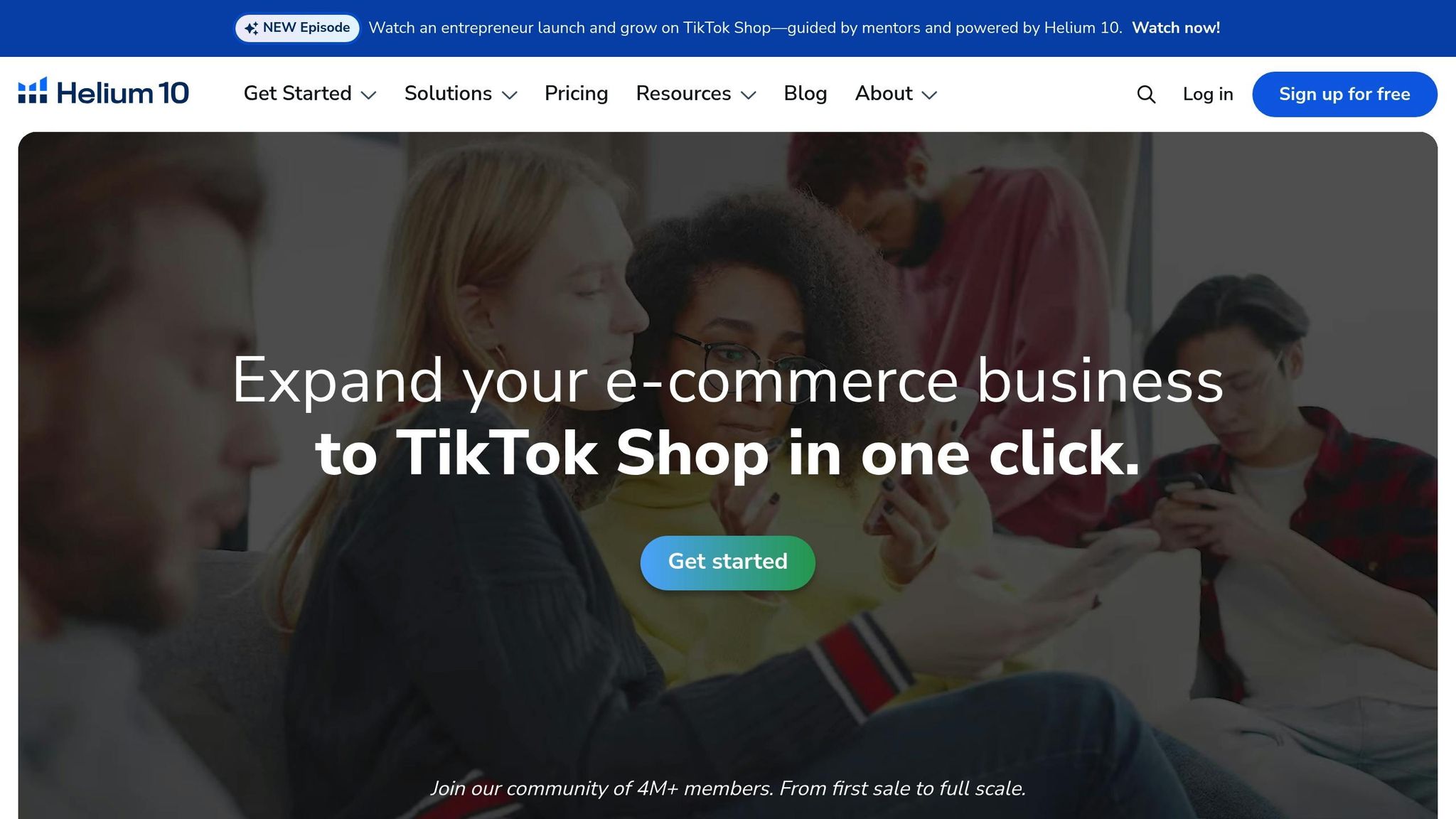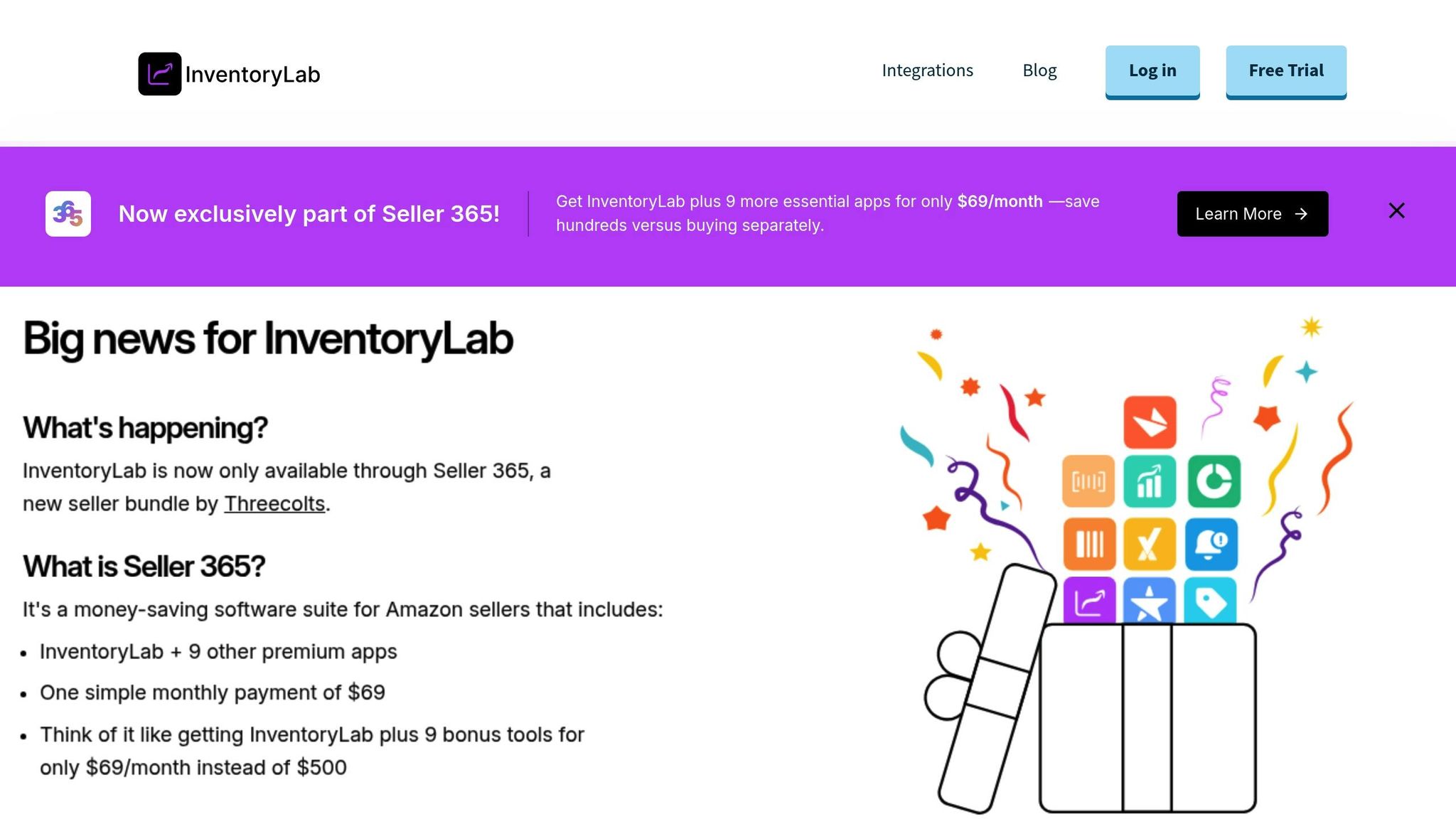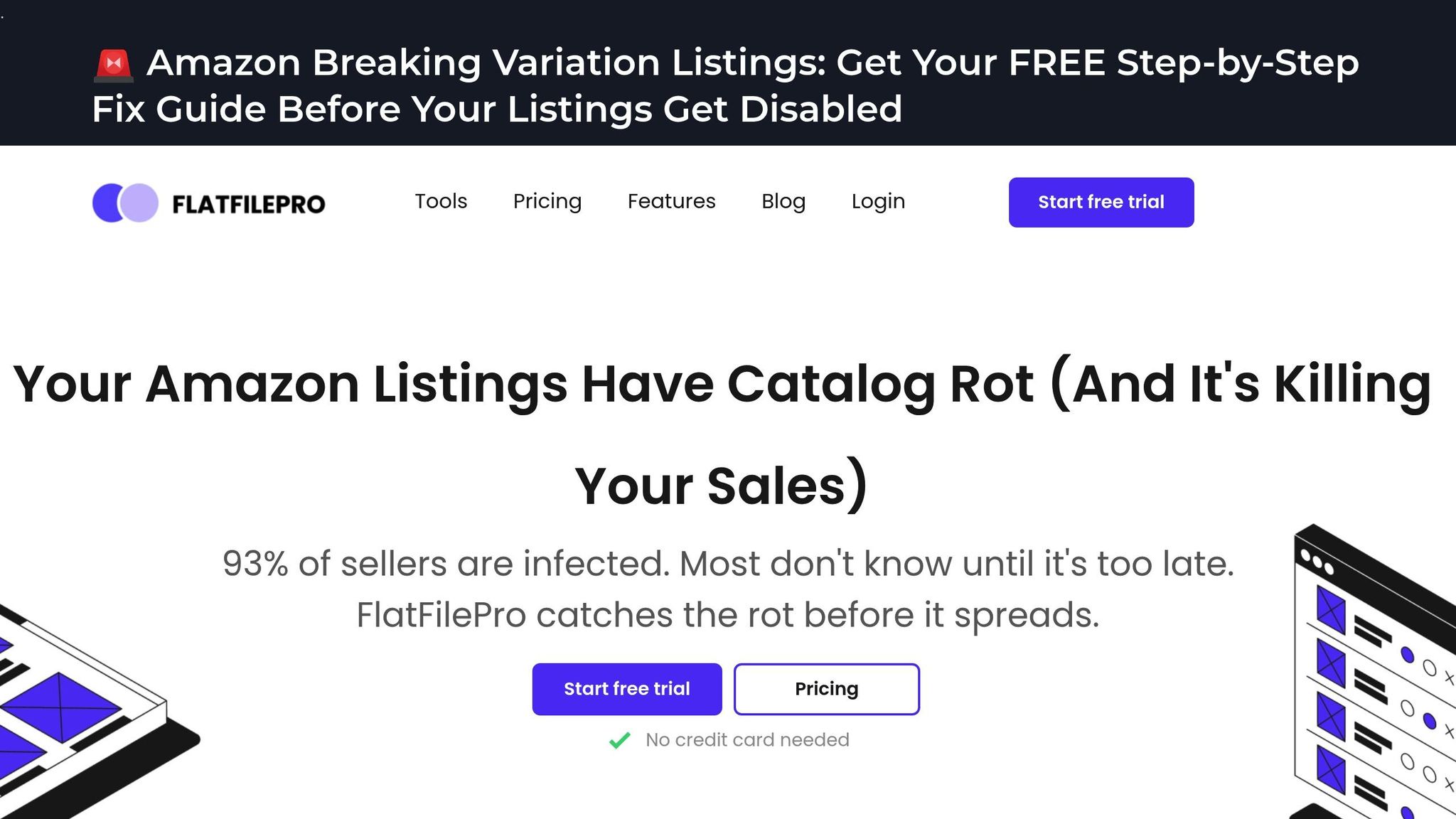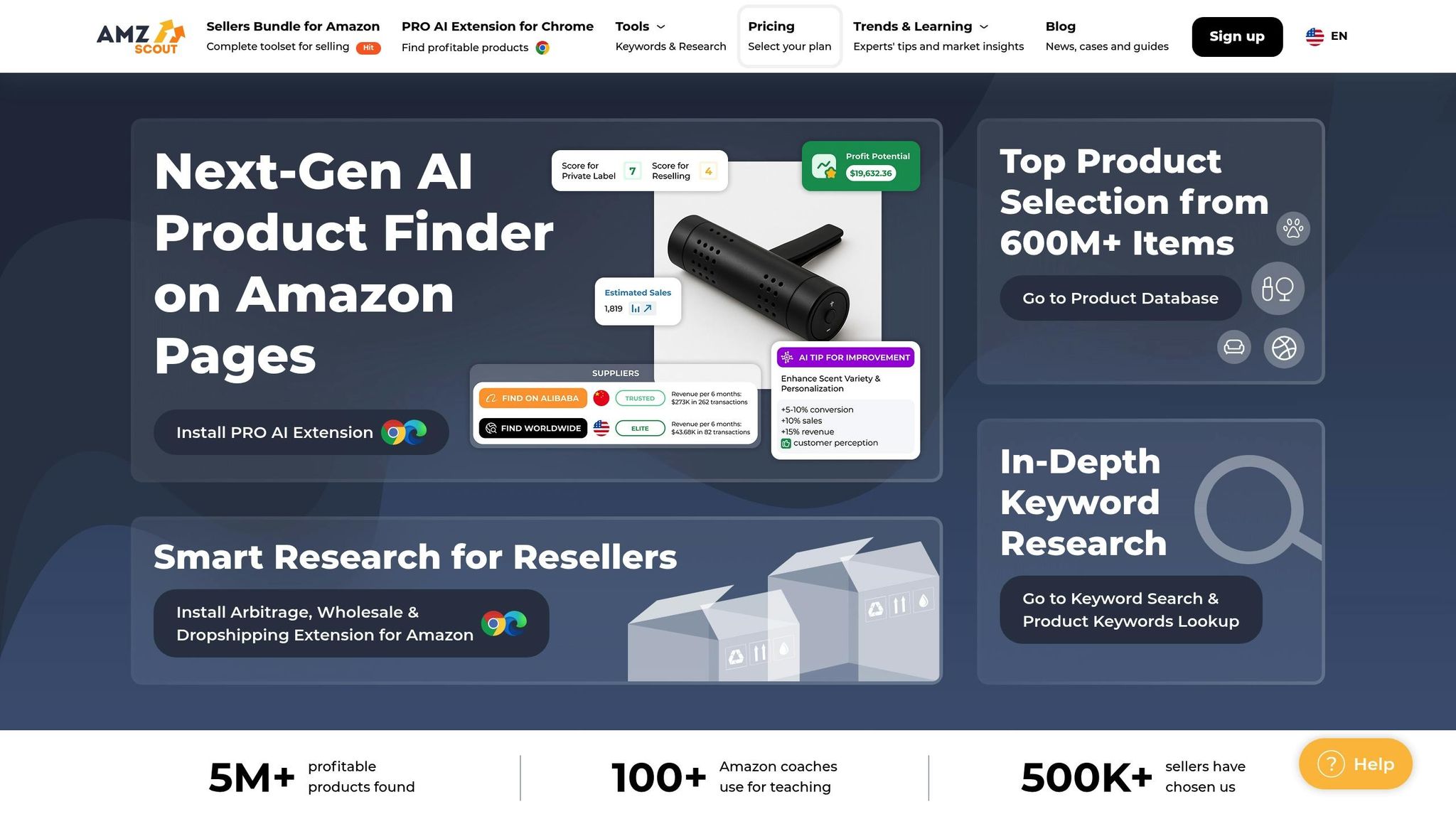Tracking sales alone won’t cut it. Hidden fees, rising ad costs, and Amazon’s ever-changing rules can eat away at your margins. That’s why profit analytics tools are a game-changer for U.S. sellers. These tools help you track every penny – down to the SKU level – so you can make smarter decisions and grow your business.
Quick Overview:
- Helium 10: Combines profit tracking with market insights. Starts at $29/month.
- Sellerboard: Real-time dashboards for precise profit tracking. Starts at $19/month.
- InventoryLab: Tracks profits and manages inventory. $69/month.
- FlatFilePro: Fixes listing errors to prevent revenue loss. $99/month.
- AMZScout: Estimates profits on new products. $59.99/month.
Why These Tools Matter:
- They automate tracking, saving you time.
- Provide real-time insights to adjust strategies fast.
- Help identify costly mistakes or underperforming products.
If you’re serious about staying competitive, these tools simplify profit tracking and help you focus on what matters most – growing your business.
Review of BEST Amazon Profit Tracking Tools for 2025 (incl. Top FREE Software for Amazon Sellers)
Best Amazon Profit Analytics Tools
Navigating the challenges of profit tracking on Amazon can be daunting, but the right tools can simplify the process and provide actionable insights. For U.S. sellers, these tools stand out by offering tailored solutions that enhance business performance. From real-time profit tracking to market analysis, each platform brings its own strengths to the table. Here’s a closer look at some of the top options.
Helium 10: All-in-One Analytics Solution
Helium 10 is a powerhouse when it comes to Amazon analytics. It combines profit tracking with market intelligence and competitor monitoring, making it a versatile tool for sellers. Its Profits dashboard functions as a profit and loss statement, breaking down revenue, expenses, and net profit across multiple marketplaces[5].
The platform also includes Market Tracker and Market Tracker 360, which provide insights into competitor activity, market trends, and shifts in product rankings. For sellers managing diverse portfolios, these features are invaluable for staying competitive. Pricing starts at $29/month for the Starter plan, with higher tiers unlocking advanced analytics and multi-market tracking. If you’re juggling multiple products and markets, Helium 10 offers the tools to make data-driven decisions.
Sellerboard: Real-Time Profit Tracking
Sellerboard is widely praised for its accuracy and real-time insights, making it a favorite among U.S. sellers. This platform automatically calculates profits while accounting for all costs, eliminating any guesswork[6]. Its multiple dashboards – such as Profit, Trend, Indirect Expenses, and Returns – offer a comprehensive view of your financials.
The Trend Dashboard is particularly useful for spotting negative spending patterns, helping sellers cut unnecessary expenses by analyzing historical data on sales, advertising costs, refunds, and more. With pricing options ranging from $19 to $79 per month, Sellerboard is accessible for sellers at any stage of their business journey.
InventoryLab: Profit Tracking Meets Inventory Management
InventoryLab goes beyond profit tracking by integrating it with inventory management, creating a seamless system for sellers. The platform tracks profits by product, supplier, or sales channel, while also automating expense accounting and supporting FBA shipment creation[3].
A standout feature is Scoutify, a mobile app that lets sellers evaluate product profitability before purchasing inventory. This reduces the risk of buying unprofitable stock by providing instant calculations based on market data and fees. InventoryLab also offers supplier-based profit analysis, helping sellers identify their most lucrative sourcing relationships. Priced at $69/month as part of the Seller 365 bundle, with a 14-day free trial, InventoryLab is a strong option for those needing both inventory and profit management in one place.
FlatFilePro: Optimizing Listings for Profit
FlatFilePro may not be a traditional profit analytics tool, but it plays a critical role in maximizing revenue by ensuring listing accuracy. Its Reflection Engine scans listings nightly, flagging discrepancies between intended and live data. This prevents revenue loss caused by catalog errors.
Jack Haldrup, Founder of Dr. Squatch, highlights its impact:
"This is the tool that powers our ops and analytics teams. We used to do everything manually, such a pain! Now we don’t have to think about anything and our listings update like magic!"
Another useful feature is the Variations Manager, which updates parent-child relationships in minutes with a 95% success rate – far faster than Seller Central. Ian Sells, Founder of Million Dollar Sellers, adds:
"With FlatFilePro, I’ve been able to streamline my Amazon listing process significantly. What used to take hours now takes just minutes. It’s a game-changer for my business."
FlatFilePro starts at $99/month, including two marketplace connectors, with additional marketplaces costing $29/month each. A 7-day free trial is available, making it easy to test its capabilities.
AMZScout: Profit Estimation and Market Insights
AMZScout focuses on helping sellers identify profitable opportunities before committing to inventory. Its product database includes advanced filters and an FBA calculator that provides instant profitability estimates based on current market conditions[5].
The Chrome extension is another standout feature, delivering real-time sales and margin data directly on Amazon product pages. This allows sellers to quickly assess potential profits while browsing. Beyond these tools, AMZScout also offers demand analysis and competitor insights to complement its profit estimations. At $59.99/month, with discounts available for annual plans, AMZScout is a solid choice for sellers looking to make informed decisions without overcomplicating their workflow.
How to Choose the Right Profit Analytics Tool
Picking the right profit analytics tool means finding one that fits your business size and offers the features you need.
Business size determines your tool requirements. If you’re a small seller managing 50–500 listings, you’ll need a tool that handles basic profit calculations, such as tracking revenue, fees, and costs. For medium-sized sellers with 500–5,000 listings, look for tools that can manage multiple product categories, handle complex fee structures, and integrate with advertising platforms to calculate metrics like ACoS. Larger businesses with 5,000+ listings – scaling up to 500,000 – should prioritize tools with high-capacity data processing, real-time analytics, and advanced reporting for operations across multiple marketplaces [1].
Key features to look for: At a minimum, your tool should offer automated profit tracking, detailed expense analysis (including referral, fulfillment, storage, and advertising fees), real-time data updates, and profit visibility at SKU, ASIN, and Parent-ASIN levels [1][7]. Other essential features include monitoring PPC performance for ad optimization, inventory management and forecasting, seamless integration with Amazon Seller Central, and advanced reporting with customizable dashboards.
Integration is critical. A good tool should automatically pull sales data, fees, ad costs, and inventory details from Amazon Seller Central [1][7]. Integration with Amazon’s advertising systems is particularly useful, as it automates the collection of Sponsored Products data, eliminating manual input and ensuring precise advertising cost attribution. For sellers working across multiple channels, choose tools that consolidate data from various sources, such as off-platform ad spending, manufacturing costs, and shipping expenses, to provide a full picture of profitability.
Scalability matters. The tool should handle up to 500,000 listings, support operations in multiple marketplaces, and accommodate international growth [1]. Cloud-based tools with strong data processing capabilities are ideal for managing growth without performance issues. Additionally, multi-user access and role-based permissions are valuable as your team expands.
Accuracy is essential. Be aware that Amazon’s dashboard can lag by 1–2 days (or up to 7 days for some fee data) [1]. Real-time tracking offers immediate insights into revenue and cost changes, helping you respond quickly to market shifts [7]. Ensure the tool accounts for all relevant fees and provides clear, transparent calculations so you can see exactly how profit figures are determined.
Pricing and ROI: Subscription plans typically range from $29 to over $99 per month. To evaluate the value, calculate the return on investment over 90 days by factoring in time saved through automation, better decision-making that improves margins, and cost reductions identified by the tool [4].
Ease of use is a priority. Tools with intuitive dashboards – featuring drag-and-drop functionality – make it easier to spot trends and track performance [2]. The best options consolidate data into a single interface, sparing you from juggling 15+ reports [2]. Use free trials (usually 7–14 days) to test how well the tool aligns with your workflow and whether your team finds it easy to use. Look for tools that offer ROI guarantees or refund policies to reduce financial risk.
Trying out different tools through free trials is a smart way to see if they fit your business needs. These trials help you gauge how well the tool integrates with your processes and whether the interface is user-friendly for your team. Tools with refund policies or ROI guarantees can also provide extra peace of mind.
sbb-itb-ed4fa17
Tool Comparison: Features and Pricing
Now that we’ve delved into each tool’s functionality, let’s break down their key features and pricing to help you make an informed decision. Below, you’ll see how these tools stack up in areas like profit tracking, error detection, and support for multi-market operations.
Feature and Price Comparison Table
| Tool | Monthly Price (USD) | Profit Tracking | Error Detection | Inventory Management | Unique Features | Best For |
|---|---|---|---|---|---|---|
| Helium 10 | $29 – $229 | Automated profit tracking with advanced reporting | Basic listing alerts | Limited inventory insights | Comprehensive keyword research and market analysis | Sellers looking for an all-in-one analytics suite |
| Sellerboard | $19 – $79 | Real-time profit dashboards | Standard error notifications | Basic stock alerts | Live profit tracking with instant updates | FBA sellers focused on accuracy |
| InventoryLab | $69 (Seller 365 bundle) | Integrated profit analytics | Standard listing warnings | Advanced inventory forecasting and alerts | Combines profit tracking with logistics management | Sellers handling complex inventory needs |
| FlatFilePro | $99 (base), $29 per additional marketplace | Indirect profit impact through listing optimization | Reflection Engine with nightly automated checks | Not included | Listing accuracy monitoring with green/red status indicators | Sellers managing 100+ listings and seeking error prevention |
| AMZScout | $59.99 | Profit estimation based on market data | – | – | Market research and competitor analysis | Sellers exploring new product opportunities |
Breaking Down the Tools
Each tool offers distinct features and pricing tailored to different seller needs. Let’s explore some highlights:
- Helium 10 provides one of the most comprehensive toolkits, with pricing that reflects its broad functionality. Its keyword research and market analysis tools make it ideal for sellers seeking an all-in-one solution.
- Sellerboard, starting at $19/month, is a budget-friendly option for smaller sellers who prioritize profit accuracy. Its real-time dashboards update as sales happen, keeping you informed at every step.
- InventoryLab stands out with its $69/month plan, which combines profit tracking with logistics management. This makes it a strong choice for sellers juggling financial and operational tasks.
- FlatFilePro takes a unique approach by focusing on listing accuracy rather than direct profit tracking. Its Reflection Engine automatically checks listings nightly, flagging errors with clear visual indicators – green checkmarks for accuracy and red X’s for issues. This tool is perfect for sellers managing large inventories, especially those with 100+ listings.
- AMZScout is geared toward sellers expanding into new product categories. It emphasizes market research and competitor analysis, offering profit estimations based on market trends rather than ongoing tracking.
Multi-Marketplace Support and Pricing
Efficiently managing multiple marketplaces can significantly boost profitability. FlatFilePro charges $29/month for each additional marketplace beyond the two included in its $99 base plan, ensuring smooth operations across global listings. Other tools may include multi-marketplace support in their standard pricing, but feature availability can vary depending on the region.
Free Trials and Guarantees
Most tools offer free trials, typically lasting 7 to 14 days. FlatFilePro goes a step further with an ROI guarantee, promising a full refund within six months if you don’t find value in the tool.
Matching Tools to Your Needs
Each tool shines in its own way:
- Helium 10: Perfect for sellers who want a powerful, all-encompassing analytics suite.
- Sellerboard: Best for those who need precise, real-time profit tracking.
- InventoryLab: Ideal for sellers requiring a blend of financial and logistical management.
- FlatFilePro: A great fit for sellers combating "catalog rot" with proactive error detection.
- AMZScout: Tailored for sellers exploring new product opportunities.
With these insights, you can align your choice with the specific needs of your Amazon business.
Conclusion
Amazon sellers looking to maximize their ROI should consider using advanced profit analytics tools. These platforms take the guesswork out of managing your business by offering real-time insights into revenue, expenses, and net margins for every product in your catalog. Sellers who switch to these tools often see a noticeable boost in profitability – some report as much as a 30% increase in profit margins compared to those relying on manual tracking methods or basic spreadsheets[2].
Take, for example, a mid-sized seller using Sellerboard. By utilizing automated cost tracking and real-time profit dashboards, they achieved a 15% increase in net profit within just three months[7][6]. This improvement came from pinpointing underperforming SKUs and reallocating ad spend to focus on high-margin products – small changes with big impacts.
When choosing the right platform, it’s important to match the tool to your business size and needs. For sellers managing extensive catalogs of hundreds or even thousands of SKUs, options like Helium 10 or FlatFilePro can be worth the investment. The time saved on manual processes alone often justifies the higher subscription costs.
Another key aspect of profitability is maintaining accurate product listings. While profit analytics tools primarily focus on revenue and expenses, ensuring your listings are error-free helps prevent lost sales and contributes to steady growth.
If you’re unsure which platform will work best for you, take advantage of the free trials many tools offer. Most platforms provide trial periods ranging from 7 to 14 days, allowing you to test their features with your actual business data. FlatFilePro even goes a step further with a six-month ROI guarantee – if the tool doesn’t deliver value, you’ll get a full refund. This makes experimenting with these tools a low-risk way to find the perfect fit for your business.
As competition on Amazon continues to heat up, making data-driven decisions is no longer optional – it’s essential. Whether your focus is on real-time profit tracking, market analysis, or improving listing accuracy, the right analytics tool can transform how you manage your business. Investing in these platforms turns profit tracking into a proactive strategy, setting you up for long-term success in an increasingly competitive marketplace.
FAQs
How can profit analytics tools help Amazon sellers boost their business performance?
Profit analytics tools give Amazon sellers the ability to simplify their workflows and boost profits. These tools help uncover hidden issues in product listings, enabling sellers to fix potential problems before they hurt sales. Plus, they can save hours of work by allowing sellers to make bulk updates to hundreds of listings with just a few clicks.
Sellers can also organize parent-child product variations effortlessly using drag-and-drop functionality, keeping product listings neat and structured. A centralized dashboard makes it easy to manage listings across multiple international marketplaces, streamlining global operations and enhancing overall efficiency.
What should I look for in a profit analytics tool for my Amazon business?
When choosing a profit analytics tool for your Amazon business, focus on features that simplify tasks and enhance productivity. Opt for tools that support bulk listing updates, make managing parent-child product relationships straightforward, and offer an overview of your global listings from one centralized dashboard.
It’s also important to select a tool that can spot and correct listing errors, keeping your product data accurate and competitive. A well-chosen tool can cut down on manual work, streamline your processes, and ultimately improve your profitability.
Can these tools integrate with other platforms and manage data from multiple Amazon marketplaces?
FlatFilePro makes managing listings across various Amazon marketplaces – like the US, UK, and Germany – effortless, all from one account. With its centralized dashboard, you can handle international catalogs without breaking a sweat, saving both time and energy.
What sets this tool apart is its ability to maintain consistency and accuracy across marketplaces. By syncing data several times a day, it eliminates the hassle of manual updates and ensures you’re always up-to-date. For sellers with extensive or varied product catalogs, this simplifies global operations in a big way.





